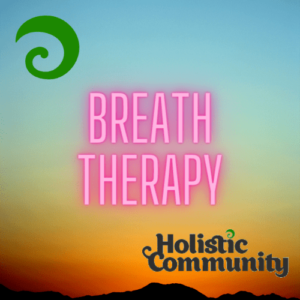 Breath Therapy (Breath integration therapy) is a meditative and therapeutic approach (body and mind) involving conscious and intentional altered states of natural breathing patterns. Two techniques exist in this approach: hyperventilation and deep-breathing. The former technique produces a high frequency of shallow breaths, while the latter technique is intended to produce slow, controlled breaths. These two techniques are sometimes performed simultaneously. Breath therapy involves using these techniques in order to achieve altered states of consciousness and achieve physical or psychological well- being.
Breath Therapy (Breath integration therapy) is a meditative and therapeutic approach (body and mind) involving conscious and intentional altered states of natural breathing patterns. Two techniques exist in this approach: hyperventilation and deep-breathing. The former technique produces a high frequency of shallow breaths, while the latter technique is intended to produce slow, controlled breaths. These two techniques are sometimes performed simultaneously. Breath therapy involves using these techniques in order to achieve altered states of consciousness and achieve physical or psychological well- being.
Breath Therapy – A Bridge between Mind and Body
Breath is the most natural and powerful tool we have to heal ourselves. It is a bridge between our mind and body, and it can be used to create balance in both. For spiritual growth or healing has been used in various traditions for many centuries. In the Buddhist context, breathwork is called “shikan taza” (literally “the fourfold purification” or “cessation through tranquility”), as it was taught by Shakyamuni Buddha to his followers.
Breath therapy techniques are a way of harnessing the power of the breath to improve your health and achieve balance of mind and body. It is a way to connect with our inner self, to find balance, and to heal. Breath therapy techniques are used for many different purposes. They can be used for relaxation, stress relief, pain management, or even as a form of meditation. When you breathe in, you take in oxygen and focus the mind. When you exhale, you expel carbon dioxide from the body, which can be helpful for those who experience low levels of carbon dioxide or those who are hyperventilating.
Breathwork is a popular form of alternative therapy that has become increasingly popular within contemporary society. Breathwork attempts to re-connect the individual to a state of inner peace and balance while also seeking to open up one’s consciousness. In some cases, breathwork is used as a form of meditation or relaxation. However, breathwork can also be used in conjunction with other forms of alternative therapy such as eating disorders and body dysmorphic disorder. Breathwork is often performed during a period of rest or relaxation with the intention of promoting healing and relaxation.
Breath Therapy (BreathWork) is sometimes called pranayama (Sanskrit: “to lengthen life”) in India and Asia. The word derives from two Sanskrit words: prana meaning vital life force, and ayama meaning to increase or expand.In this type of yoga , the practitioner focuses their concentration on different parts of the body. For example, a practitioner focusing on the abdomen is said to be doing pranayama practises. Pranayama is beneficial for people with respiratory problems.
Integrative Breathing Therapy (IBT) is a more evidence based and holistic approach to breathing therapy and breathing retraining. IBT seeks to optimize the airways function and re train nasal breathing, also improving muscle function and posture. There is a lot of conflicting information on the best way to breathe. Many experts point out that we are designed to breath from our noses (using the nose-only approach). To engage our lungs using shallow breathing and slow exhalation, encouraging more oxygen in to our blood stream, in turn this supports health and well-being.
In contrast, there are several things that we should avoid when it comes to breathing. Be aware of how food affects your diaphragm and lungs and avoid eating large amounts of food (don’t overeat). Allow your diaphragm and lungs room to function. Meals should correlate to energy levels and activity. Avoid gaseous foods or drinks. Potentially, avoid liquids that are acidic or high in water content like juice, milk, soda and beer. It can also make the tissues more sensitive to acid, which can lead to heartburn. Alcohol is acknowledged as a contributory factor to acid reflux interacting with the stomach on numerous levels. Ideally eat smaller meals and more frequently and avoid eating at night.
